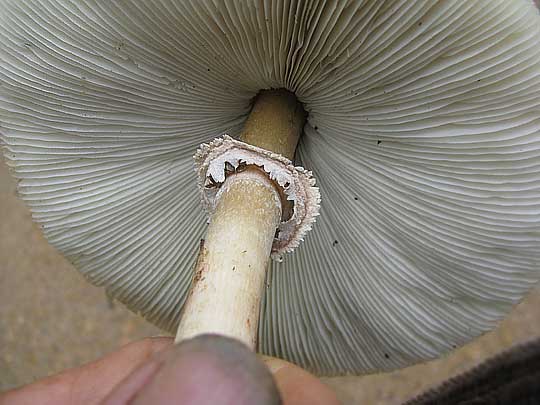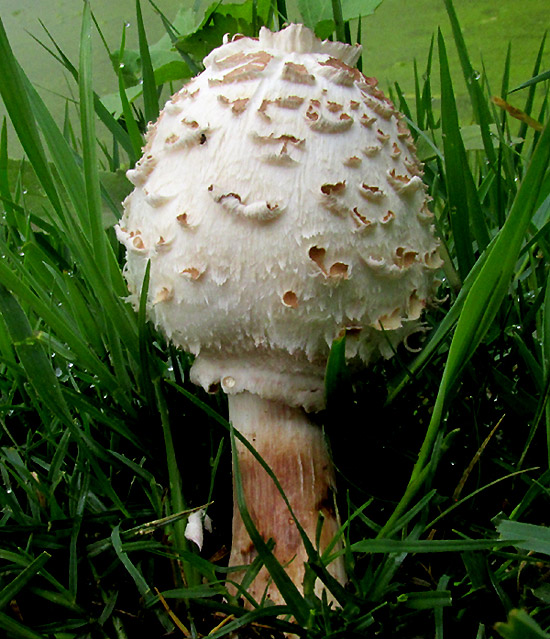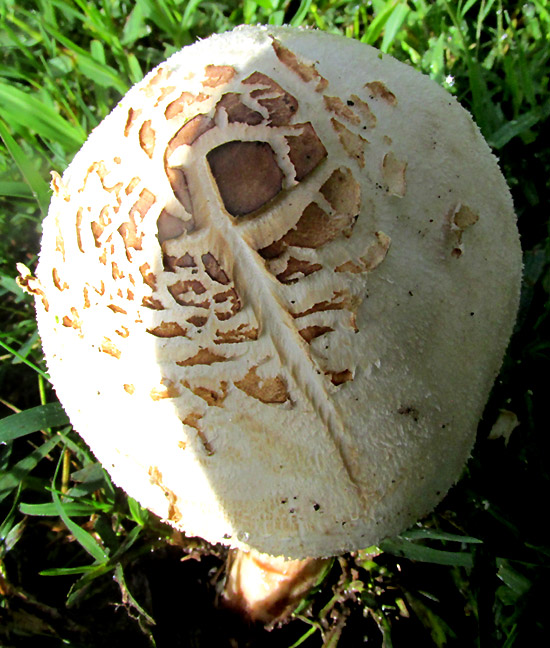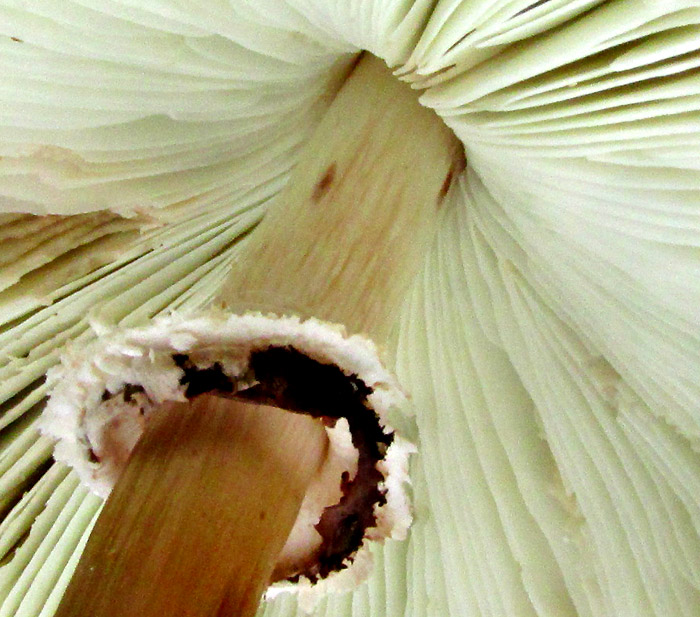Excerpts from Jim Conrad's
Naturalist Newsletter

from the October 18, 2009 Newsletter, from near Natchez, Mississippi
A STOMACH-WRENCHING MUSHROOM
Heavy recent rains have made for great mushroom hunting. In a neighbor's pasture where for years horses have been kept, this week some mushrooms caught my attention that caused my poor stomach to wrench with a sudden cramp. You can see exactly what I saw above.
What you see there is a bunch of large, white-capped mushrooms beneath a tree in the junky corner of the pasture where the horses usually gather. Notice that the mushrooms grow more or less in a line. That can be interpreted as one small section of a large "fairy ring," or a circle of mushrooms. Some mushroom species form fairy rings but others don't. Most fairy rings are incomplete like this one but sometimes perfect circles form where mushrooms arise at the tips of outward-growing mycelia, which started growing from a single spore originally at the circle's center.
The reason my stomach reacted so violently is that I hadn't seen anything exactly like this since the summer of 2006, when up in Kentucky's Bluegrass Region I got seriously ill after misidentifying a poisonous Chlorophyllum mushroom as an edible one. The whole story of what happened and how I misidentified it can be read in the entry following this one.
My Kentucky mushrooms had been larger than these, however, so maybe they'd been different. Up close, however, their structure looked the same, as shown below:

The five-inch-broad cap (13 cm) is white, with patches of white "skin" pealing off the top. Notice the "ring" around the stem. The ring is somewhat distinctive, displaying two jagged edges. Another shot of that ring -- and many mushroom species don't have rings -- is below:

Finally, just like the Chlorophyllum that almost killed me, the cap's gills do not at all connect to the stem -- they're "free." That's another important mushroom-identifying field mark, for the gills of many mushroom species attach to the stem or maybe even run down the stem for a distance.
At this point I was starting to think that I had the same species that poisoned me in Kentucky, but I needed a final determination, which would rest on the spore color. I remember the poisonous Kentucky mushroom's spore very well because my misidentification of the species had resulted from bad information about the spore color. All my books had said that any mushroom looking like what I had, to be poisonous, would have to have green spores, which is an unusual spore color. Up in Kentucky my mushroom had produced gray spores, so, according to my books, my mushroom should have been edible.
You can see what spore color our Mississippi mushroom has below:

Gray spores. They're exactly the color of those of the Chlorophyllum mushroom that almost got me in Kentucky!
In fact, the mushrooms in our neighbors horse pasture are indeed the poisonous Chlorophyllum mushroom, sometimes called the Green-gilled Lepiota or Green-spored Parasol Mushroom. It's CHLOROPHYLLUM MOLYBDITES.
On the Internet I find other spore prints of this species and they're all gray colored exactly like mine. Yet every mushroom-identification book I have -- five on my desk right now -- claims that the species produces green spores.
How many dummies such as I have been poisoned because they consider the spore color revealed in my spore print to be gray instead of green?
Chlorophyllum molybdites causes more mushroom poisonings in the US than any other species. Fortunately for me, the toxin affects only the guts, but does not destroy the nerves or blood, as do some other species.
Entry dated July 8, 2023, issued from near Tequisquiapan, elevation about 1,900m (6200 ft), Querétaro state, MÉXICO
(~N20.57°, ~W99.89°)
A DIFFERENT VIEW

The small pond with its grassy bank existed during the current long-term drought because of the negligence of big landowners at the head of the gully; habitually they let their water pumps keep pumping groundwater long after their irrigated fields are saturated, and the water accumulates here. The above emerging mushroom was one of four in a bed-size area. Notice how brown scales covering the cap are unattached along all their edges, that a ring encircles the stalk immediately below the cap, and the stalk is mostly brown.

On the above larger, more developed neighbor of the above, the cap has expanded and most of the loose-edged brown scales have come off, but brown patches still cover the cap's center, with the largest patches at the cap's peak.

The above mature cap, the largest in the group, was 6cm across (2-1/3inches). The stem was even browner than on the younger mushroom.

The stalk's ring, sometimes described as double-edged, was curiously blackened on its underside, and was "mobile" -- not physically attached to the stalk. Notice that a kind of notch develops where the gills meet the stalk. On many mushroom species, gills attach to the stalk, and even descend down its sides.

With such a scaly top and a ringed stalk, this could have been one of numerous species of the famously toxic but sometimes highly edible Amanitas, genus Amanita. However, the stalks of Amanitas either arise from a cuplike volva, or toward the stalk base may show scaly remains of the "universal veil," which is the temporary membranous tissue covering the egglike immature mushroom body before it emerges from the soil. Above, the stem is seen with soil scraped away from the base revealing no volva and no hints of a former universal veil. Also, note the horizontal indentation in the stem. That's where a thumbnail was pressed into the flesh to see if a colored bruise resulted. A slight brownness formed, but nothing like the bruises many mushroom species develop.

The above spore print turned out a bit tricky looking. The spores seem to be tan colored, but if you notice where the spores concentrate, they're almost white. The spore print color looks different from that shown in the above photo. However, maybe that's due to the black background. This spore color is tricky, as made clear in the following entry.
from the August 24, 2006 Newsletter, from Polly's Bend, Garrard County, in Kentucky's Bluegrass Region
POISONED BY A CHLOROPHYLLUM MUSHROOM
It's been warm and rainy lately so I've been keeping my eyes peeled for mushrooms. The ones I spotted last Saturday didn't need sharp eyes to see, though, for their whitish caps were seven inches across (20 cm) on stems 11 inches tall (28 cm).
I had an idea that this was the "Parasol Mushroom" of the genus Lepiota, considered choice eating. As soon as I saw them I started anticipating eating on them for several days. However, in the genus Lepiota there are poisonous species, so I knew to be careful.
The first step in confirming the identification was to make a spore print -- to place the mushroom cap on a surface with the gills facing downward so spores would accumulate when released from the gills.
Spore color is one of the main features to note during mushroom identification. Amanita species are the most poisonous of mushrooms and they all produce white spores. The meadow mushrooms, genus Agaricus, are a little similar to Amanitas but they are wonderful eating and have chocolate-brown spores. Most mushroom field guides group their mushrooms according to spore color. My field guide color-groups are white to yellowish, salmon to pink, black to smoky gray, purple-brown to chocolate-brown, clay color, and yellow-brown, rusty-brown, or cinnamon-brown to clay-brown.
Saturday's mushroom produced pale gray spores, which was unusual. To be the hoped-for Parasol Mushroom it needed white spores. However, Parasol Mushrooms are very variable so I thought that maybe mine just had some anomalously colored spores. There were a few other departures from the Parasol Mushroom as well, but maybe they also were part of the normal variation. Few mushrooms produce gray spores, and my discovery clearly wasn't any of the listed gray-spored species. I needed to be careful before I ate these.
I decided to run a nibble test. The idea is pretty simple: You eat a small amount and see what happens. If that goes well you eat a bit more, and then a bit more, until you're sure you have an edible species.
I took half a mouthful and the taste was so bland, like unsweetened custard, that I grew even surer that my discovery was edible. The inedible mushrooms I've tested before were so bitter, foul-tasting or nauseous-smelling that I wouldn't have wanted to eat them anyway. This tasted so good that I took a tiny bit more, but no more in total than a single mouthful.
Two hours later I started feeling queasy and experiencing shortness of breath. Without being too graphic I'll just say that for the next hour I endured six waves of debilitating vomiting, and that passed into severe diarrhea. Terrible chills alternated with fevers that steamed my glasses. My neck muscles and other muscles contracted and ached. Twelve hours later I was exhausted, still experiencing waves of chills, fevers and shortness of breath, and 24 hours later I still had some diarrhea. It was a mess.
Once I knew I'd nibbled a poisonous species it became much easier to work out the identification. I had eaten the Green-spored Parasol Mushroom, CHLOROPHYLLUM MOLYBDITES. The reason I'd misidentified it was because all my books said that this species produces green spores, yet my specimens definitely produced pale gray ones. Also, the books say that older gills on the poisonous species turn green, but mine turned blue.
Once I knew that I'd been poisoned I looked up the toxin I was dealing with. It was a "Group VI" toxin, gastrointestinal in nature. This was good news. I didn't want it to be one that attacked my nervous system or blood. Group VI toxins are unpleasant but, unless eaten in large quantities, not deadly.
It turns out that of all mushroom poisonings in the US the Green-spored Parasol causes by far the most. I just wonder if it's because of this spore-color and gill-color confusion?
Whatever the case, I am a bit chastened, have learned to not trust this spore-color business as much as I have in the past, and now I know for sure that some poisonous mushrooms can taste pretty good.